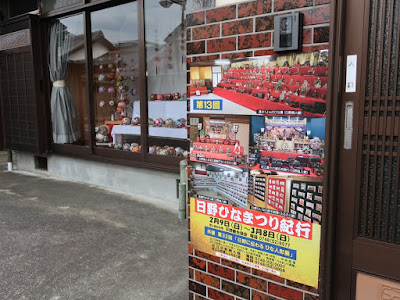Hino
town is located in Ohmi region which is the home town of many merchants. Hino
merchants peddled along Nakasendou (highway) and the north of Tokyo. They made
distributors there, and they also opened small companies in the north of Tokyo
(Kita-Kantou region), which included many sake (alcohol) or soy sauce brewers.
I visited this place during the Girls’ Festival (Hina matsuri) season, so Hina dolls were
displayed on the first floor.
By the way, I wonder why
people in the inland like Hino tried to peddle; they didn’t concentrate on
agriculture. Their mutual aid system and their network supported their
business, and the open mind to the strangers also made them start business
under the foreign sky, I just reckon.
Regarding to the fun of Hino
people, I regard that they enjoy working and contributing to the society
rather than entertaining themselves.
The building of the museum was owned by Yamanaka family (Hino merchant) and it is designated the cultural asset.
資料館である日野商人・山中兵右衛門宅は国指定の登録有形文化財になっている。
The bonsai of Japanese plum trees started blooming.
玄関脇の盆栽の梅が咲き始めていた。
琵琶湖の南東、日野町出身の日野商人は、関東平野や中山道沿いに特約店を作り行商を行い、埼玉、群馬、栃木では小規模店を出店していった。酒や醤油などの醸造が多かったという。ひな祭り時期に訪問したので、1階はお雛様の展示だ。
正直、なんでこんな内陸部の人たちが、農業だけでなく、各地を行商するようになったのかと思った。大当番という独特のチームと街道のネットワークを作った先輩商人達、そして、町ぐるみのひな祭りで見せてくれた日野の人のおもてなし精神=よその土地の人への親しみがあってこそ、町を出て商売をしようという気になったのだと思う。
人生の楽しみ方としては、娯楽よりも、しっかり仕事して世間のお役に立っている=人生を楽しんでいる、という感じだ。
Hino wooden bowls (right) and Kannougan medicine (left) were their major products. They peddled these and expanded their business.
入口には、日野の主力商品、日野椀と万病感応丸を展示している。これらの行商から商売を大きくしていった。
Around ten sets of Hina dolls were displayed on the first floor. It was a luxurious view.
1階のお雛様。10セット程展示してあり、圧巻だ。
This is the Hina dolls of Shono family who developed the said medicine. It was made in 1852 by a doll artist in Kyoto. It was popular among merchants in the late 19th century to order these showy dolls.
大ヒット商品になった「万病感応丸」を開発した正野家の御殿雛。1852年に京都の人形師が作ったものだが、幕末の商人達は競ってこのような雛を作ったという。
This doll who is a garden keeper joins the party and drinks sake. I like his harmless and happy face.
階段下のお庭番・仕丁は、お祝いのご相伴に預かり、酒を飲んでいる。何ともお気楽そうな表情で好きだ。
Exhibits about Hino merchants
日野商人についての展示
日野商人についての展示
二階には、パネルがぎっしりと壁に貼られてある。ポスターでの説明がてんこ盛りだ。
More than four hundred merchants joined the membership of “Hino Oo Touban” which shared the market information and supplied goods for trade in order to support the member’s business. It was established in 1690 approximately. Only Hino merchants had such a mutual aid association, however neighboring merchant could join it.
400人を越える日野商人が加盟していた「日野大当番仲間」は情報交換、商品や原材料供給などで個々の加盟者の商売を支える仕組みだ。1690年頃にはできていたという。近江商人の中では日野商人だけが組合を作っていた。
Inn’s flier: “Hino Oo Touban” designated inns at various areas for the safe trip, and merchants also used them as business and logistic bases. It was good for the inns to be designated, because other travelers trusted such inns. So, they advertised that they were designated by Hino Oo Toban. Regular inns are nice in my experience, we can relax there.
各地に定宿を指定し、道中の安全を確保するとともに、商売や物流の拠点にしていた。宿は、日野商人に指定されることが、ブランドになって良かったという。指定されていることを宣伝している。私のサラリーマン経験では、定宿は家に帰ったようでとにかく落ち着く。
Outfit of a peddler: business trip is fun on some days, and difficult on another also in my experience. The statue on the right is a Hino peddler in the Hino elementary school.
行商の装束。仕事での旅は、楽しいことあり、辛いことありだったと思う。右は小学校に立っている日野商人像。天秤棒を杖にして立っている。
Many travel gears are exhibited including a wooden passport.
旅の道具も沢山展示。木札の通行手形もあった。
Yamanaka’s family precepts “Ten articles regarding Tsutsushimi (moderation)”. The firm mantra is needed to be prosperous continuously.
山中家の家訓「慎み十ヶ条」もしっかりと展示されている。繁栄を継続させるには、しっかりとした理念が必要だ。
These are paper crafts called “Origata” which were attached on the gifts. Creative ones showed the best wishes of senders; making them were the common sense among women.
贈答品に添えた「折形」。今は「のし紙」だが、かなり大きい。工夫を凝らした折形を付けて真心を伝えた。女性のたしなみでもあったという。
Gekkin (moon guitar) became very popular in the late 19th century. The fashionable lady enjoyed playing.
中国から輸入された月琴は、江戸末期から日清戦争で敵性楽器と言われるまで大いに流行した。奏でている女性が竹下夢二っぽい。
This is the oldest domestic wine made in 1905; it was brewed in Ushiku, Ibaraki.
現存する最古の国産ワイン。1905年頃の牛久葡萄酒(茨城県)だ。
”Hoi-nobori” festival: people offer the labara called “Hoi-nobori” to the shrine, and pray for their health and the rich crop. It is held from the beginning of April to the 1st of May, then, Hino festival is held on the 2nd and 3rd of May. Sixteen floats join it. It’s a comfortable climate and everyone looks happy.
「ほいのぼり」と呼ばれるのぼりを神社に奉納し、無病息災や豊作を願うほいのぼり祭は、4月初めから5月1日まで町内の七カ所の神社で行われている。5月2日、3日は16基の曳山が出る日野祭りだ。皆さん楽しそう。
Inner courtyard is well trimmed. 中庭も良い。
Hino town、日野の街
In front of the museum, mountains were covered with snow.
資料館前の道。山には雪が残っています。
Tourist information center “Machikado Kannou-kan”; it was built by Shono family who manufactured Kannougan medicine which is made even now.
万病感応丸を作った正野家を活用した観光案内所のまちかど感応館。感応丸は今も販売されている。
“Hino Hina-matsuri(festival) Kiko” was held from the 9th of February to the 8th of March this year. Private houses showed their Hina dolls to the public.
訪問時は、「日野ひなまつり紀行」というイベント中で、一般のご家庭も雛飾りを街路から見えるようにしています。
This house, which is opposite of the museum, decorated Hina dolls even around the gate. Those were tiny and adorable.
商人館の向かいのこちらの家は、門の脇の雛飾りも可愛い。
This house set the windows at the wall in order to show Hina dolls inside the house. In this town, residents including children greeted me often. Visitors are welcome here.
壁をくり抜いて、お雛様を見られるようにしている家もある。街を歩いていると、「こんにちは」と声をかけられることが多く、よそ者を歓迎するおもてなし精神を感じる。
There are storehouses of Hino festival floats in the town.
曳山の倉庫が街中に点々とある。
The town
is surrounded by fields. It’s peaceful.
町外れはもう田園風景。のどかだ。
Website:
http://www.town.shiga-hino.lg.jp/category_list.php?frmCd=20-1-0-0-0
(in Japanese), accessed in March, 2020
Visited in February, 2020
Previous post (Merchant museums in the same region):
Museums inOhmi Gokasho (2)、近江・五個荘の資料館(2)
Next post (Castle museum in the same prefecture):
Azuchi castle museum 安土城郭資料館
























Comments
Post a Comment